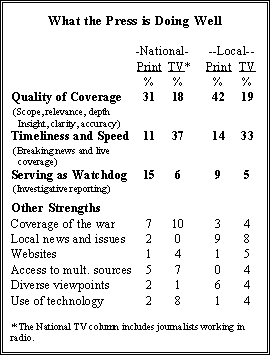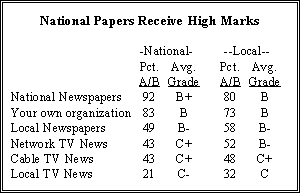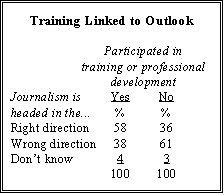 Journalists are divided over whether their profession is advancing or regressing. Only about half of local journalists and even fewer national journalists feel their profession is moving in the right direction. In particular, national TV and radio journalists are the most negative, with 61% saying the field is headed in the wrong direction, compared with just 33% who say the opposite.
Journalists are divided over whether their profession is advancing or regressing. Only about half of local journalists and even fewer national journalists feel their profession is moving in the right direction. In particular, national TV and radio journalists are the most negative, with 61% saying the field is headed in the wrong direction, compared with just 33% who say the opposite.
There also is a significant divide between executives and reporters in these national organizations, with executives seeing the profession headed in the right direction (by a 57% to 38% margin) while reporters say things are declining (by 54% to 39%).

Continuing Concerns Over Quality
Problems with the quality of coverage remains a major concern of journalists, but an increasing percentage mention business and financial factors. A plurality of national journalists (41%) cite quality concerns such as sensationalistic coverage; the need for accuracy; and a lack of depth, relevance and objectivity as the most important problems facing their profession. Collectively, these were also the top concerns volunteered by national journalists in 1999, and in a similar survey a decade earlier.
Among local journalists, however, business and financial problems are now mentioned as frequently as concerns over the quality of coverage. More than a third of local news people (35%) cite business and financial factors as the biggest problem facing journalism, up from 25% five years ago.
Print Journalists Worried About Losing Readers
 There are significant differences among journalists in different media, as well as those working at local and national news organizations, over the biggest problem confronting journalism. Broadcast journalists, especially at the national level, cite issues relating to quality much more often than do their print counterparts. Roughly half of national broadcast journalists (51%) cite quality concerns, compared with 32% of national print journalists.
There are significant differences among journalists in different media, as well as those working at local and national news organizations, over the biggest problem confronting journalism. Broadcast journalists, especially at the national level, cite issues relating to quality much more often than do their print counterparts. Roughly half of national broadcast journalists (51%) cite quality concerns, compared with 32% of national print journalists.
By comparison, declining readership is cited by 15% of print journalists at both national and local news organizations, but no more than 2% of broadcast journalists view loss of audience as the most important concern. Instead, broadcast journalists view limits on resources and the pressure to make profits and get bigger ratings as the biggest financial problems.
Despite the growing concern over business and financial issues, fewer journalists mention an overly competitive media environment as the biggest problem. In 1999, 17% of national and 15% of local journalists specifically mentioned increasing competition as a problem; just 5% of national and 2% of local journalists say this today.
While the quality of coverage and business concerns are seen as the leading problems facing journalism, the single word mentioned more frequently than any other by journalists assessing their profession is “credibility.” Roughly a quarter of both national and local journalists mentioned problems with public trust and confidence in some form, and one-in-five specifically mentioned credibility as the biggest concern for the profession.
Print journalists are far more likely than those in broadcast to see credibility as the biggest problem facing journalism today. Four-in-ten (39%) journalists working at national newspapers, magazines and wire services say credibility is the biggest problem, compared with just 15% at national TV and radio outlets. And this gap exists at the local level as well, with local print journalists nearly three-times as likely as local broadcast journalists (33% vs. 12%) to cite credibility as their greatest concern.
 There is also a sizeable difference between younger and older journalists in perceptions of the credibility problem. Just one-in-ten journalists under age 35 cite concerns about credibility and public trust as the biggest problem facing the profession, compared with about quarter of those age 35 to 54 (26%), and a third of those age 55 and older.
There is also a sizeable difference between younger and older journalists in perceptions of the credibility problem. Just one-in-ten journalists under age 35 cite concerns about credibility and public trust as the biggest problem facing the profession, compared with about quarter of those age 35 to 54 (26%), and a third of those age 55 and older.
Though a number of journalists specifically mentioned recent scandals involving New York Times reporter Jayson Blair and USA Today’s Jack Kelley in describing why the profession has lost credibility with the public, relatively few expressed concerns with any broader ethical problems in their field. In fact, just 5% of national journalists (and 6% of local news people) cite ethics or a lack of standards as the biggest problem in journalism, about half as many as in the 1999 survey.
Plagiarism Not Widespread
The vast majority of journalists of all backgrounds and at all workplaces say that plagiarism is no more prevalent today than it has been in the past, just more of a focus on the problem. More than seven-in-ten national (77%) and local (72%) journalists agree with the statement “We are hearing more about plagiarism but its prevalence has not increased.” About one-in-five at both the national and local level (21% of national journalists, 23% local) say there is more plagiarism today than in the past.
There is virtually no difference across different groups of journalists in this perception. Broadcast and print journalists, as well as executives, senior editors, and reporters all predominantly say that recent incidents of plagiarism do not signify a wider problem in the field. There is similarly no difference in this view between young and old, those who are more and less experienced, or those who are more and less educated.

What the Press is Doing Well
Print and broadcast journalists also differ over what journalism is doing well these days. Print journalists most often point to the quality and depth of
coverage that is provided. They describe the volume of topics covered, coverage with context and insight, and an ability to make the news interesting and relevant. Fully 42% of local print journalists and 31% of their national counterparts cited some aspect of the quality of coverage as journalism’s best performance trait, compared with just 18% of local broadcast journalists and 19% of national broadcast journalists.
 Those working in television and radio are more likely to cite the timeliness and speed of reporting as what journalism is doing best today. Among local journalists, broadcast journalists are more than twice as likely as those working in print (33% vs. 14%) to cite the immediate coverage of live and breaking news as journalism’s greatest strength. This gap is even wider within the national press, with 37% of national broadcast journalists and just 11% of national print journalists citing timeliness and speed as the best aspect of today’s news.
Those working in television and radio are more likely to cite the timeliness and speed of reporting as what journalism is doing best today. Among local journalists, broadcast journalists are more than twice as likely as those working in print (33% vs. 14%) to cite the immediate coverage of live and breaking news as journalism’s greatest strength. This gap is even wider within the national press, with 37% of national broadcast journalists and just 11% of national print journalists citing timeliness and speed as the best aspect of today’s news.
The watchdog role of the press is cited as journalism’s strength by fewer in the field. Print journalists are about twice as likely as those in broadcasting to say investigative reporting and watchdog journalism is what the press is doing well these days.
By contrast, those in TV and radio make far more mention of the value of news websites and the use of production technology to better deliver news to the public.
As was the case five years ago, roughly half of journalists say the profession does a good job of striking a balance between what audiences want to know and what’s important for them to know.
 This opinion is held by comparable numbers of national and local journalists, as well as among those working in both print, broadcast, and Internet media.
This opinion is held by comparable numbers of national and local journalists, as well as among those working in both print, broadcast, and Internet media.
Criticisms of the Press
Nearly eight-in-ten in both national and local news organizations believe the criticism that the press pays too little attention to complex issues is valid (78% national, 77% local). This is comparable to findings in previous press surveys conducted in 1995 and 1999. Roughly two-thirds also agree that there are too many talk shows on cable television today, and this view is shared equally by both print and broadcast journalists.
Most journalists also accept as valid the criticism that the distinction between reporting and commentary has seriously eroded, although the percentage who cite this as a valid criticism has, if anything, declined since 1999. However, far more national and local journalists regard this as a legitimate critique than did so in 1995.
 A growing number of national journalists, in particular, say news reports are increasingly full of factual errors and sloppy reporting. The number of national journalists who view this as a valid criticism has increased steadily from 30% in 1995 to 40% in 1999 to 45% today. A comparable percentage of local journalists say this is a valid criticism (47%). That represents a decline from 1999 (55%), but is higher than the 1995 level (40%).
A growing number of national journalists, in particular, say news reports are increasingly full of factual errors and sloppy reporting. The number of national journalists who view this as a valid criticism has increased steadily from 30% in 1995 to 40% in 1999 to 45% today. A comparable percentage of local journalists say this is a valid criticism (47%). That represents a decline from 1999 (55%), but is higher than the 1995 level (40%).
In both 1995 and 1999, slim majorities agreed with the criticism that the press was too cynical, but this perception has ebbed among both national (37%) and local (40%) journalists today. In fact, more national journalists say the press is too timid (47%) than too cynical. In addition, the proportion who feel the press can be criticized for becoming out of touch with their audience has dropped slightly within both groups of journalists.
Grading the Media
 Journalists give the highest ratings to major national newspapers 92% of national journalists and 80% of local journalists give national newspapers a grade of A or B. By contrast, local TV news receives the lowest grades; just 32% of local journalists say local TV news outlets deserve a grade of A or B and national journalists’ grades are even lower (21% A or B).
Journalists give the highest ratings to major national newspapers 92% of national journalists and 80% of local journalists give national newspapers a grade of A or B. By contrast, local TV news receives the lowest grades; just 32% of local journalists say local TV news outlets deserve a grade of A or B and national journalists’ grades are even lower (21% A or B).
Grades for other news media network TV news, cable TV news, and local newspapers fall somewhere in between national newspapers and local TV news. In that regard, little has changed from nine years ago, when journalists gave very similar grades to these media organizations.
 Most journalists give their own news organization middling grades. Just 22% of national journalists, and 14% of local journalists, gave their organization an A, though roughly six-in-ten of both groups gave their own organization a grade in the B range. These grades also are similar to the grades journalists assigned in 1995.
Most journalists give their own news organization middling grades. Just 22% of national journalists, and 14% of local journalists, gave their organization an A, though roughly six-in-ten of both groups gave their own organization a grade in the B range. These grades also are similar to the grades journalists assigned in 1995.
Print journalists are particularly critical of network and local TV news. Just 32% of national print journalists give favorable grades (A or B) to network TV news, while twice as many (65%) assign grades of C or D. Journalists at local newspapers are, at most, only slightly more favorable. By comparison, a majority of journalists working at both national and local TV and radio outlets give favorable grades to network news programs.
Nearly half (47%) of local TV journalists give favorable grades to their own field’s performance, compared with only 18% of local print journalists. The print/broadcast gap is slightly narrower among journalists at national outlets, but only because ratings of local TV news are low among all national reporters whether in print or broadcasting. Among broadcast media, cable TV news channels are the exception to the media divide, as they are graded similarly by both print and TV/radio journalists.
Journalists were also asked to give a grade to national news organizations for their websites, and the marks were fairly strong. Sizable majorities of both national (70%) and local (57%) journalists gave grades of A or B to major media websites. And the grades among local journalists are lower only because more said they were unable to rate these websites very few in either group gave poor marks to the websites.
Why is Journalism on the Wrong Track?
In the general evaluation of whether their profession is headed in the right direction or the wrong direction, journalists were almost evenly divided in their view. While those taking a pessimistic view were not asked directly what they had in mind, an analysis of their responses to other questions provides some indication of the factors behind this opinion.
In particular, journalists who say things are going badly are significantly more likely to take their profession and employers to task for the quality of the news product. They believe the press has become too timid, and almost unanimously say the press pays too little attention to complex issues. Nearly three-quarters of journalists who say the profession is headed in the wrong direction say the distinction between reporting and commentary has seriously eroded, compared with only half of those who think things are on the right track.
 Concerns about the impact of bottom-line pressures also are far more prevalent among those saying the profession is on the wrong track, which is closely related to concerns about sloppy reporting and the increasing commercialization of the news. Many say the emergence of the 24-hour news cycle has weakened journalism and that news reports are increasingly full of factual errors. And those critical of the overall direction of journalism more frequently cite sensationalistic reporting and an emphasis on ratings as the biggest problems facing the profession.
Concerns about the impact of bottom-line pressures also are far more prevalent among those saying the profession is on the wrong track, which is closely related to concerns about sloppy reporting and the increasing commercialization of the news. Many say the emergence of the 24-hour news cycle has weakened journalism and that news reports are increasingly full of factual errors. And those critical of the overall direction of journalism more frequently cite sensationalistic reporting and an emphasis on ratings as the biggest problems facing the profession.
Within the newsroom, those who are unhappy with the leadership of their own news organization are far more negative about the profession as a whole compared with those who are satisfied with their bosses. In addition, those who have participated in training or professional development over the past 12 months are significantly more optimistic about the profession as a whole than those who have had no such training.
 But overall cynicism about journalism is not simply an expression of sour grapes on the part of those who have faced economic pressures or staffing cuts at their own place of work. Those who have seen their newsrooms shrink, or who say that resource and staffing limitations are the biggest problem facing the profession, are no more or less likely to be negative about the direction of journalism than those who have not faced resource limitations.
But overall cynicism about journalism is not simply an expression of sour grapes on the part of those who have faced economic pressures or staffing cuts at their own place of work. Those who have seen their newsrooms shrink, or who say that resource and staffing limitations are the biggest problem facing the profession, are no more or less likely to be negative about the direction of journalism than those who have not faced resource limitations.
Similarly, there are no generational or ideological divides on this general evaluation of the state of the profession. Journalists young and old, liberal, moderate and conservative are all about evenly divided in terms of whether they are optimistic or pessimistic about the field.


